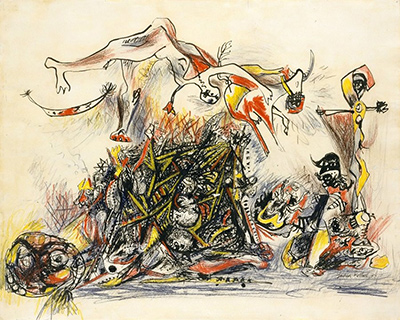Jackson Polllock’s early work featured a popular surrealist style, revealing a personal dimension to Pollock, exposing his psychological state of mind.
Pollock's War (1947) was created between 1943 and 1944, during the Second World War (1939-1945). It is the only drawing that he titled and one of the most iconic paintings he produced.
Some art critics have suggested that the imagery in Pollock’s ‘War’ was inspired by Pablo Picasso’s interpretations of warfare: for example, a pair of etchings by Picasso called “The Dream and Lie of Franco” (1939).
Visually, ‘War’ is a powerful and complex image, which expresses the chaos and suffering of war.
The composition subtly uses a cream background colour, representing the horror of suffocating mustard gas in the grim trenches, and drawing your eyes into the burning pyre in the centre of the portrait, where the monstrous destruction of war emerges.
The artistic execution begins to convey the pain, suffering and death caused by conflict.
The linear pencil strokes (cleverly highlighted in flashes of red, yellow and black) focus your eyes on the pile of bodies and limbs that camouflage the indistinguishable horror and human debris in the centre of the painting.
The fierce graphic imagery and the use of many darkened and thickened linear motions express the emotional and psychological consequences of warfare. Overall, it espouses a sombre mood.
But this painting is more than an expression of the horrific nature of war: it is a narrative that tells a story. At the top of the painting, a bull and human figure are painted as if they are being flung onto this burning pyre.
Standing on the right-hand side of the portrait, a hooded figure is being executed.
The sheer size and scale of the pyre and what is happening to these figures in the painting make a powerful statement on the horrors of war, and a powerful artistic statement by Jackson Pollock.




